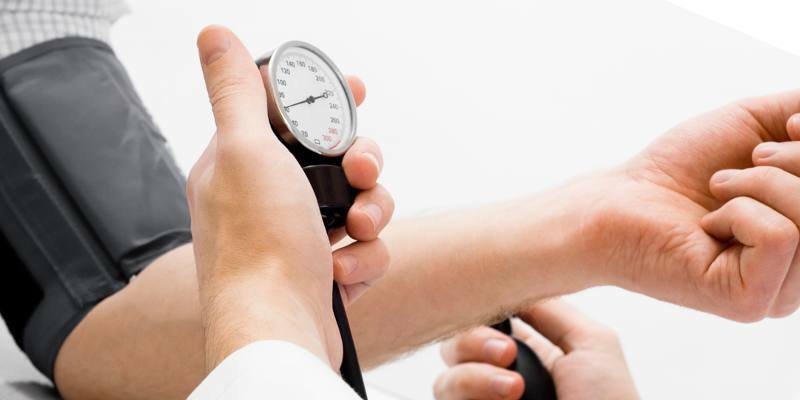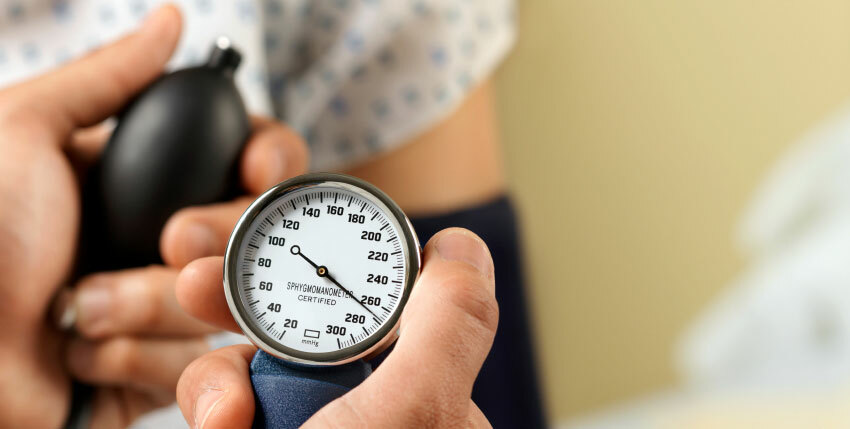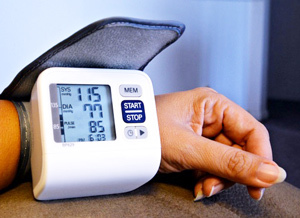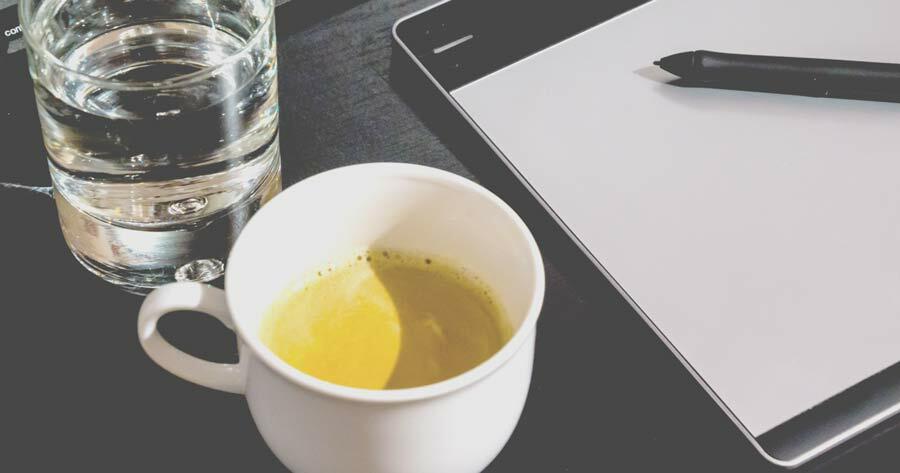 Photo: Pressure jumps - then low, then high
Photo: Pressure jumps - then low, then high Page content
- 1 Blood pressure norm
- 2 What is the danger?
- 3 Why does the pressure jump that is low, that high?
- 4 Clinical picture
- 5 Pressure rises low, then high - treatment
Sudden changes in blood pressure( BP) - a dangerous condition, which poses a serious threat not only to health, but also to a person's life. What if pressure rushes low, high and how to avoid possible complications? To begin with, it is necessary to determine the cause of sudden pressure surges, since in 80% of cases this condition is a consequence of another disease. Therefore, young and healthy people rarely have unstable blood pressure, whereas in the elderly, there are already problems with pressure in every third patient.
Blood pressure norm

At the therapist's reception, each of us passes through the blood pressure measurement procedure, because this indicator characterizes the general condition of the body and gives an idea of the cardiovascular system. In medicine, the normal blood pressure index is a figure of 120/80.However, this does not mean that the slightest deviation in one direction or another is a serious pathology.
So, for some patients, 100/60 pressure is absolutely normal, while others feel great at 130/90.If such deviations from the generally accepted norm do not give a person discomfort, then it says only about the individual characteristics of the organism. Therefore, doctors consider this pressure to be "working" and do not see any reason to adjust it medically.
What is the danger?

Quite another matter - sharp jumps of arterial pressure, which lead to deterioration of well-being and significantly worsen the quality of life. At such times, the risk of serious complications increases sharply( heart attacks, strokes).For example, in hypertensive patients, vessels constantly experience increased pressure, as a result, the walls of arteries eventually sclerosis, thicken and the lumen in them narrows.
They can withstand high loads for a long time, but at some point( at a sudden pressure jump) they can not stand and break. Especially large is the risk of hemorrhage in elderly patients suffering from hypertension( high blood pressure) and atherosclerosis, in which the vessels become brittle, and the lumen inside them is clogged with cholesterol plaques.
Hypotonics also have a hard time, because with a low blood pressure a person constantly feels weakness, lethargy and apathy. A sharp drop in pressure can cause fainting and lead to the development of hypoxia( a violation of the supply of oxygen to the tissues), which most negatively affects the state of the vessels of the brain and heart. Therefore, it is so important to determine in a timely manner the cause of sudden pressure surges and take measures to normalize it.
Why does the pressure jump that is low, then high?

What is the reason that the pressure rises is low, then high? Doctors can name dozens of factors provoking changes in blood pressure. Let us highlight the most common of them:
- Heredity. Pressure problems often occur in those patients whose immediate relatives suffer from hyper- or hypotension.
- Features of lifestyle and diet. Lack of physical activity( hypodynamia), alcohol and tobacco abuse, infatuation with caffeine-containing beverages - all this negatively affects the state of the vessels. If we add to these negative factors an unbalanced diet with a predominance of oily, spicy food, and foods stuffed with preservatives and artificial additives, then BP disorders can not be avoided.
- Chronic stress factor, psychoemotional stress, nervous breakdowns, overfatigue - scourge of modern society. In a complex they provoke disturbances from various systems of an organism and cause problems with pressure.
- Diseases of the endocrine, nervous, cardiovascular system, kidney pathology, hormonal failures are serious causes provoking BP changes.
The instability of pressure can be influenced by taking medications, excessive physical and mental stress, spine diseases( osteochondrosis), vascular disorders.
In addition, there is a special category of meteodependent people. In this case, sudden pressure surges cause a change in weather, changes in atmospheric pressure, a change in climate and time zones during flights and travel. The cardiovascular system of these people is sensitive to any changes, which results in a deterioration in the state of health and the appearance of symptoms that indicate a blood pressure surge.
Clinical picture

At the doctor's office, patients are usually interested in what to do if the pressure rises, then low, then high? It is difficult to give a unambiguous answer to this question, it is necessary to have a thorough examination and to collect an anamnesis to identify the causes that cause this condition. The first thing the doctor must do is to measure blood pressure and ask the patient about the characteristic symptoms.
Signs of a sharp rise in blood pressure are:
- severe headaches;
- dizziness;
- cardiac rhythm disturbance;
- pain in the region of the heart;
- nausea( sometimes attacks of vomiting);
- tinnitus;
- intense sweating;
- "midges" before the eyes.
Characteristic manifestations of BP fall are:
- pronounced migraine;
- weakness, lethargy, general malaise;
- nausea;
- darkening in eyes;
- fainting( in severe cases, loss of consciousness);
- tachycardia;
- degradation of operation.
It is difficult to judge for an ignorant person on the basis of external symptoms whether the blood pressure is raised or lowered, but nevertheless, there are characteristic signs that make it possible to distinguish a hypertonic from a hypotonic.
Low blood pressure is typical for people with vegeto-vascular dystonia. Accordingly, the type of hypotonic is a pale, lean, apathetic person. During an attack, working capacity drops to almost zero and the patient tends to lie down, becomes sleepy and sluggish. Typically, young people suffer from hypotension, and often a cup of strong coffee or tea helps them to normalize the pressure.
At the same time, you can not always sit on the "caffeine needle", it negatively affects the work of the heart muscle. With age, former hypotonic patients often begin to suffer from BP elevations, and these jumps suffer very poorly and even a slight increase in indices, which goes unnoticed for a healthy person, is perceived seriously.
Risk of drop in blood pressure
 Photo: Low pressure
Photo: Low pressure The sharp drop in BP against a background of an infectious disease or allergic reaction is especially dangerous. In this situation, blood circulation is disrupted due to a decrease in vascular tone and a person can faint.
The fall often leads to serious injuries, especially in those categories of people whose professional activities are related to working mechanisms or to the altitude. A separate situation when an attack occurs at the driver of a vehicle, in this case it is not only the patient's health, but also the safety and lives of passengers and pedestrians.
The greatest danger to the body is a sharp increase in blood pressure. Against the background of impaired blood circulation, all organs and tissues are affected, the walls of arterial vessels are affected. The first stroke is taken by the vessels of the brain, the retina of the eyes, the heart, the kidneys.
With regular pressure surges, cardiac rhythm is disturbed, as the heart, trying to adapt to changes in blood circulation, increases in size. Its walls thicken, but the existing vessels that feed the heart muscle are not enough to ensure the normal functioning of the organ. As a result, the reserve capacity of the heart is gradually depleted, and the risk of developing ischemic disease, chronic heart failure or cardiosclerosis is repeatedly increased.
The situation with pressure jumps is perhaps the most difficult in terms of diagnosis and treatment. Often, such a condition develops against a background of menopause, pregnancy, diabetes, hormonal failures, vascular disorders or bad habits.
The patient will undergo a full examination with the involvement of such specialists as endocrinologist, cardiologist, neurologist, urologist. The task of the attending physician is to identify the cause of the pathology, so as to abandon all efforts to eliminate it.
Pressure rises then low, then high - treatment

If you are prone to pressure changes, take any medication only as directed by your doctor. Self-treatment is dangerous, because only a specialist can choose the appropriate treatment regimen and dosage of drugs taking into account the clinical picture, concomitant diseases and possible contraindications. But a few basic ways to help alleviate the condition of the patient, everyone should know.
How to help hypertension?
If you feel the characteristic symptoms indicating an increase in pressure, you need to calm down, ventilate the room and try to lie down, at least for 10 -15 minutes. Reduce the pressure before the arrival of a doctor will help intake of herbal decoctions with diuretic action or Furosemide tablets. You can wash yourself with cool water or simply dip your hands to your shoulders for several minutes into running water.
A good method - respiratory gymnastics, it will help to normalize the heart rate and reduce the pressure by 10-20 mm.rt. Art. Exercises are built on deep breaths and slow exhalations, they should be performed within 10 minutes.
 tablets Nifedipine
tablets Nifedipine If such attacks occurred earlier and the doctor has already prescribed you a medicine designed to reduce blood pressure, be sure to take the drug. It can be a tablet of Nifedipine( which is put under the tongue) of Enalapril or Corinfar.
If the attack happened for the first time, and you can not remove the pressure indicators, you should not experiment with drugs before the doctor comes. Otherwise, taking a strong pill from high blood pressure, the hypotonic can worsen the condition, as the blood pressure drops sharply, which will lead to fainting and other severe consequences.
To hypertensive doctors, it is recommended to completely exclude salt, caffeine-containing drinks and alcohol from the diet. Liquid intake should be limited, completely abandon the pickles and marinades, otherwise the risk of edema and increased blood pressure increases. Try not to be nervous, avoid conflicts and other stressful situations. A good effect is given by practicing yoga, mastering the techniques of relaxation and meditation.
Increasingly recently, doctors recommend a new drug on natural ingredients - Rekardio.
How to help hypotonic?

If you feel dizzy, there is a strong weakness, dizziness, nausea - it may have been a drop in blood pressure. How to be first aid hypotonic?
- must be laid down to avoid the risk of falling with fainting;
- unbutton the collar to facilitate airflow;
- make you drink a cup of strong coffee or tea;
- give a little quality brandy or Cahors( 50 grams) or add a balm of healing herbs to tea;
- if there is no coffee, you can put on the tongue a little ordinary table salt or give a piece of salted fish, salted vegetables( tomato, cucumber);
- raise blood pressure and help a sweet way - sometimes enough to eat a candy or take a couple of glucose tablets.
Preparations on a plant basis

Safe preparations for increasing blood pressure are herbal preparations( Saparal, Eleutherococcus extract), but the reception of such products should be agreed with the doctor.
These simple methods will help to quickly raise the pressure in emergency cases. Well, those hypotonic patients, for whom low blood pressure has become familiar, can be advised to exercise caution. In the morning, after waking up, do not suddenly get up off the bed, a sudden change in body position can cause dizziness and cause a fall. This is especially dangerous for the elderly. Hypotonics with experience are recommended first to sit in bed, then lower their legs to the floor and only after that get up.
For this category of patients it will be useful to take a contrast shower, play sports, quit smoking and adhere to the diet. You need to eat often, but in small portions, not allowing long breaks between meals. Otherwise, forced starvation can provoke a sharp drop in pressure.
Traditional medicine
 dogrose
dogrose The action of folk recipes is aimed at improving cardiac activity, strengthening blood vessels, improving kidney function, which helps normalize blood pressure. To do this, use the means tested by time: decoctions of medicinal plants, beekeeping products and other natural natural components, harmless to health.
Rosehip tincture.
Used to normalize the pressure and eliminate sudden changes, dangerous for their complications. The rose hip can be bought at the pharmacy, but it's best to cook it yourself. For this, the hips are crushed and poured into vodka in a 1: 5 ratio. The capacity is closed and sent to a dark place for 2 weeks. Then the ready tincture is filtered and taken 10-12 drops twice a day before meals.
Another option is vitamin liqueur from rose hips. Prepare it in the same proportion, only the fruit of the dog rose is filled not with vodka, but with dry red wine. Ready tincture take 50 ml before each meal.
Bee honey

Honey is a universal product that helps with many diseases. At pressure surges, liquid lime honey and finely chopped young nettle can be mixed in equal proportions. This mixture is recommended to take one large spoon every morning, washed down not with tea, but with cool boiled water.
Herbal collection.

Normalize the pressure will help the decoction of lavender, mint, thyme, lyubistok, motherwort and marjoram, taken in equal quantities. Vegetable raw materials are poured with boiling water in a proportion of 1:10, put on a weak fire. Boil the grass is not necessary, as soon as the first bubbles appear on the surface, remove the container from the heat, cover with a lid and insist 30 minutes. After that, the broth is filtered and drunk throughout the day instead of tea.
Under reduced pressure, tinctures of ginseng or eleutherococcus give a good effect. They can be purchased at any pharmacy and taken as instructed. Another effective way is essential oils. If weakness occurs, the general deterioration of well-being is enough to drop a few drops of lavender, rosemary, grapefruit, lemon, cedar on the handkerchief and breathe in pairs, so that the pressure will return to normal.
People's prescriptions for the normalization of blood pressure are many, you just need to competently approach their use and before starting the application, be sure to consult a doctor.
If folk remedies do not help you to normalize the pressure, then be sure to try an effective remedy on plant ingredients that many doctors recommend. Read reviews of the medication for hypertension Normalife.



